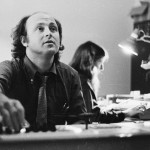
Ann has time code on the brain.
Through means that I don’t recall, we were approached by a party who was interested in developing a new-fangled way to handle retail merchandise. They wanted to develop a self-service kiosk for the S and H Green Stamps organization. The customer would count up all his books of Green Stamps, go to the redemption center, and select his reward using a CRT and a keyboard. Pretty advanced for the time.
Our job was to master a 1 inch tape with individual frames of each and every article that was presented in the Green Stamp catalog. But how to do it? We did not have a one inch machine at the time, but Bill Weston (then of 3M, now of Evertz) treated us like royalty. Even though he knew we did not have the budget for a 1 inch machine at that time, he provided us a demo-loan of a Hitachi HR-200. Bill’s a good guy in the video business and very active in the SMPTE, by the way.

Willie drives the Duca-Richardson while Dee types like crazy.
Next problem was that by my calculation, we would put a minimum of 150 passes on the tape just by doing single frame edits with a five second pre-roll. Would the tape hold up? It did!
We ripped the switcher control panel out of the control room, rolled a camera into tech center, set up the Quantafont Q-7A, dragged in a couch and table (for the pizza) and had at it.

Bob spins the trusty shuttle knob.
Bob Swanner and Willie Heinz took an active roll in the project, but Dee and Ann really put in the hours typing the text from the catalog and setting up for the seemingly endless single-frame edits. I contributed by pointing at things.

Working hard.
We delivered the one-inch master to the end user…and what became of it, no one knows. Here’s what it looked like, complete with the 16mm product demonstrations.
S and H Greenstamp Production




